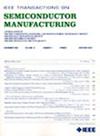Enhanced Silicon Crystallization on Dielectric Materials at Reduced Temperature
IF 2.3
3区 工程技术
Q2 ENGINEERING, ELECTRICAL & ELECTRONIC
引用次数: 0
Abstract
We report the demonstration of the crystallization of amorphous arsenic and boron-doped silicon films on dielectric substrates at reduced thermal budgets. The conventional methods to form polycrystalline silicon generally require growth temperatures of at least低温下介电材料上硅的增强结晶
我们报告了非晶砷和硼掺杂硅薄膜在介质衬底上的结晶在减少热预算的演示。形成多晶硅的常规方法通常需要至少600~ {\circ}$ C的生长温度,或高温后退火以使硅结构从非晶转变为多晶硅。在这里,我们展示了在$500~^{\circ}$ C和$550~^{\circ}$ C之间形成高质量多晶硅,这有助于减少异质结双极晶体管器件的热预算应变。这种进步是通过选择缓冲层材料和微调薄膜厚度来实现的。与结构混合硅膜相比,砷掺杂硅膜和硼掺杂硅膜的电导率分别提高了66%和1719%。薄膜的晶体性质通过顶视扫描电子显微镜和ImageJ软件分析得到确认,为晶体百分比定量提供了一种快速、在线的方法。此外,横断面透射电镜分析证实了完整的薄膜结晶。
本文章由计算机程序翻译,如有差异,请以英文原文为准。
求助全文
约1分钟内获得全文
求助全文
来源期刊

IEEE Transactions on Semiconductor Manufacturing
工程技术-工程:电子与电气
CiteScore
5.20
自引率
11.10%
发文量
101
审稿时长
3.3 months
期刊介绍:
The IEEE Transactions on Semiconductor Manufacturing addresses the challenging problems of manufacturing complex microelectronic components, especially very large scale integrated circuits (VLSI). Manufacturing these products requires precision micropatterning, precise control of materials properties, ultraclean work environments, and complex interactions of chemical, physical, electrical and mechanical processes.
 求助内容:
求助内容: 应助结果提醒方式:
应助结果提醒方式:


